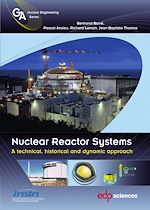
The evolution of nuclear reactors since the 1942 Fermi experiment can be described along the lines of natural history, with an initial - flourish of uninhibited creativity followed by a severe selection process leading to a handful of surviving species, with light water reactors occupying most of
the biotope today.
This book combines four approaches:
• A descriptive one. is gives an overview of the main strengths and weaknesses of the di erent reactor systems.
• A historical approach, from the 1940’s to nowadays, with an extrapolation to the near future. The LWR dominance being rmly established, what is the next step?
• An axiomatic approach. Starting with a set of long term criteria concerning the fuel cycle sustainability, a conceptual solution is established, and then a family of reactor systems is selected for development and qualification.
• A dynamic approach. In the early 2000s, the prevailing image combined a “nuclear renaissance”, a strong limitation of the greenhouse gases concentration and a dynamic growth of the world economy. Updating the strategy in the wake of the last decade events requires a sharper understanding of the driving forces as well as of the influence of the post-Fukushima safety framework on the design constraints.